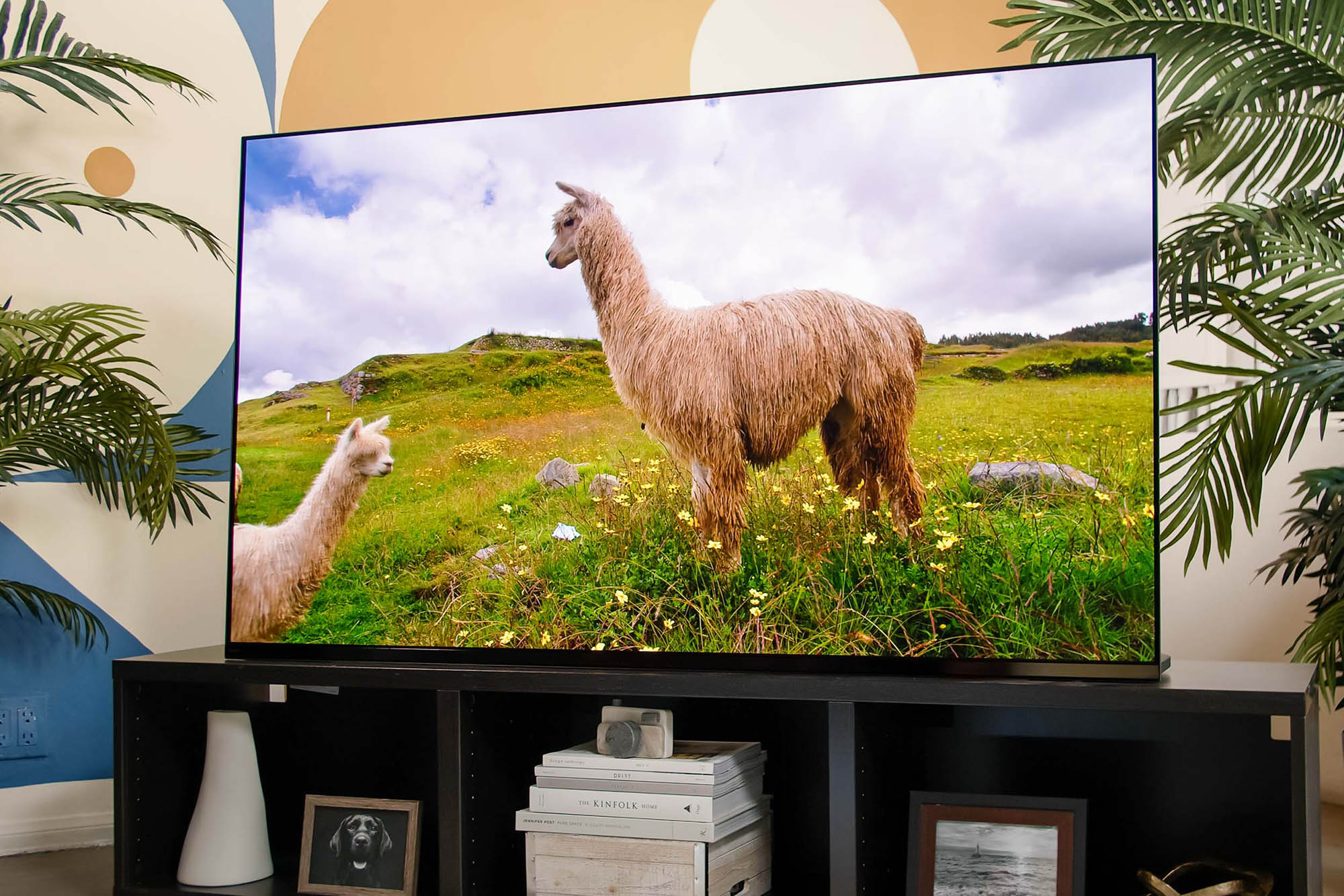What is QD-OLED? The Newest TV Tech Fully Explained
Fans of TV gear love to debate the merits of flat-panel technologies. In the past, this meant comparing Quantum Dot LED (or QLED TV as it’s most commonly known) and Organic LED, otherwise known as OLED TV. But 2022 was the year a new display technology called Quantum Dot OLED or QD-OLED, made its official debut, and it has already started to reshape the TV landscape thanks to new models from Sony and Samsung, and computer monitors from Dell’s Alienware brand.
But what exactly is QD-OLED, how is it different from both QLED and OLED, and why do experts think it represents the best picture quality you can get? Let’s take a deep dive into the details of QD-OLED and find out.
What is QD-OLED?
Simply put, QD-OLED is a hybrid display technology that takes the already very impressive qualities of OLED TV and improves its brightness and color through the use of quantum dots.
The result is a TV that exhibits the stunning levels of contrast and perfect blacks of OLED while delivering brightness levels that exceed anything we’ve seen from OLED so far.
This “best of both worlds,” benefit was largely theoretical until we got a chance to see it for ourselves at CES 2022. Those impressions survived even once we brought the first two QD-OLED TVs in for testing. First with the Sony A95K, and then again with the Samsung S95B. Both TVs earned a rare 10/10 rating from our reviewer.
Picture improvements aside, it’s also possible that over time, QD-OLED TVs may prove less expensive to buy than similarly sized OLED TVs. We’ll discuss this in more detail later. Since QD-OLED TVs are essentially an evolution of OLED, it’s expected that some of the clever things we’ve seen LG do with its OLED panels, like transparent displays and rollable displays, will soon be possible with QD-OLED, too.
How does QD-OLED work?
To understand the inner workings of QD-OLED, we need to quickly explain the differences between QLED and OLED.
QLED TV
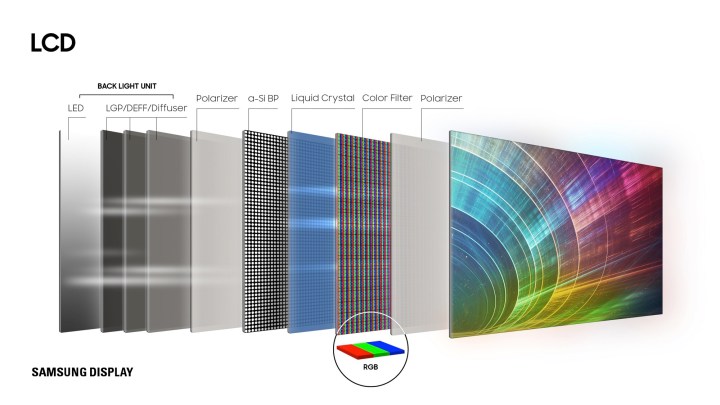
QLED TV uses four main elements to produce its pictures: An LED backlight, a layer of quantum dots, an LCD matrix, and a color filter.
The LED backlight produces all of the brightness you see — and modern LED backlights can produce a lot of brightness, far more than OLED light sources. But achieving that brightness while maintaining a full-spectrum white, is difficult.
The solution: Start with a really bright blue LED light source, then use red and green quantum dots to balance the blue into a full spectrum of white. Because quantum dots can be tuned to emit specific colors and, amazingly, can do this at a nearly 100% efficiency level, QLED TVs get a much-needed improvement to their color accuracy without sacrificing any brightness or needing to use more energy.
From there, the purified white light passes through the LCD matrix (which is responsible for the images you see, and how bright or dark areas of the screen are) and, finally, through the color filter, which converts the white light into the right amounts of red, green, and blue so that we see true color images.
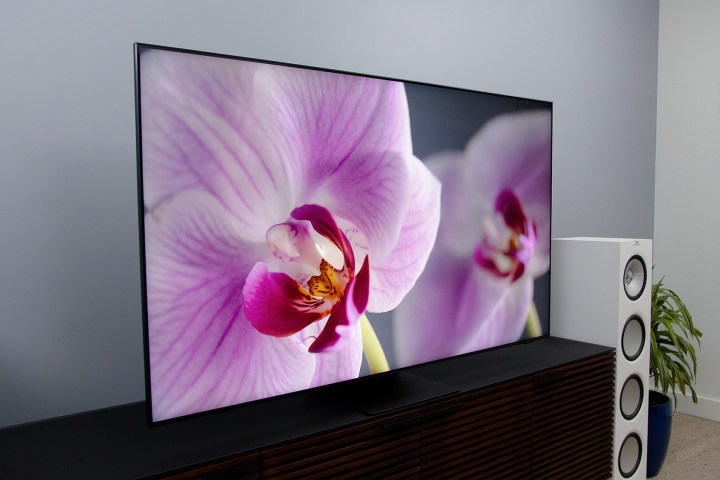
It’s a good system that produces bright and very colorful images. It’s also quite affordable to produce because, except for the quantum dots, all of the components have been around for decades, and are now “cheap” to make.
But it has drawbacks, too. No matter how hard the LCD matrix tries, it can’t block 100% of the light from coming through in dark scenes, so you never get that perfect, inky black that you see on an OLED TV. The LCD matrix also creates problems for off-angle viewing because it tends to “tunnel” light straight outward from the screen.
QLED also has to use more energy to create the brightness you see because the combination of the LCD matrix and the color filter diminishes the light the LED backlight generates. This makes QLED TVs less energy efficient than OLED TVs.
Finally, and this may only matter to decor-oriented TV buyers, all of those elements add up to a thicker overall TV panel.
OLED TV
OLED TV uses an OLED light source and a color filter to produce its image.
That sounds remarkably simple compared to QLED TV, and it is. Thanks to the emissive nature of the basic element of OLED TV — the OLED pixel — this one ingredient can take care of brightness and image creation, essentially fulfilling the roles of both the LED backlight and the LCD matrix in QLED TV.
Without an LCD matrix, viewing angles with OLED TV are as near-perfect as we’ve ever seen. You can sit wherever you like and still see the same levels of brightness, contrast, and color.
And as we’ve already hinted at, because OLED pixels can be shut off completely when an image calls for perfect blackness, that’s exactly what you get: No light being emitted at all.
But OLED TV isn’t perfect either. You can only derive so much brightness from an OLED pixel. It’s excellent in low-light conditions, but it simply can’t compete with QLED’s dedicated LED backlight in brighter environments. If you’ve ever looked at a QLED and OLED TV side by side in a brightly lit Costco warehouse and found the QLED TV more appealing, it’s probably due to its superior brightness.
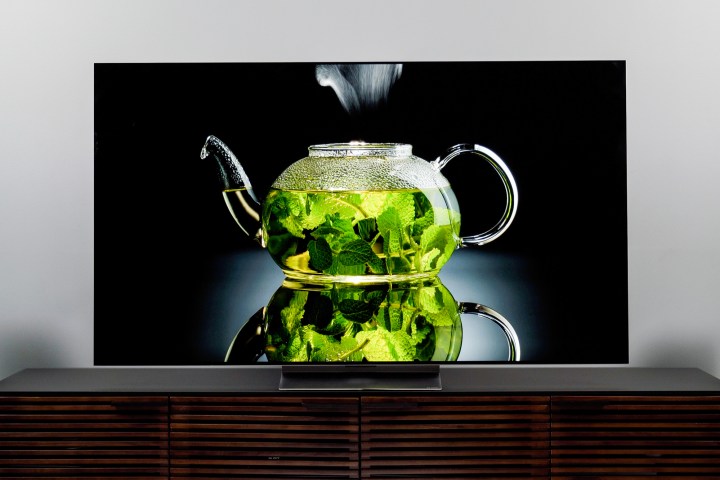
OLED TV brightness is lower than QLED for two main reasons. First, and most importantly, each OLED pixel creates its own light. But the more power you drive through an OLED pixel, the more you shorten its lifespan. So OLED TVs could probably get brighter than they do today, but few buyers would be OK with a TV that only lasted half as long. The LEDs used in a QLED TV’s backlight are far less susceptible to this kind of aging and can continue to produce lots of light for a long time.
Second, no matter how much light an OLED pixel can create, some of that light will be absorbed by the color filter.
OLED panels are also susceptible to something known as burn-in. If you display the same kind of content on an OLED TV for tons of consecutive hours — say a lower info banner on a news channel, or a control panel in a video game — it can cause those pixels to age at a faster rate than the pixels that are constantly displaying different images.
The residual “shadow” of that static content is called burn-in, and once it happens, it’s usually permanent.
Finally, because the large-format OLED panel market is effectively a monopoly, with just one company — LG Display — manufacturing and selling them to companies like LG, Sony, Philips, and Vizio, it will remain more expensive than QLED for some time to come.
QD-OLED: Busting the brightness barrier
So the question that faces the TV world is, how can you hold on to all of OLED’s many benefits and improve on its weaknesses?
The solution is QD-OLED, also referred to by some companies as “QD Display.”
Quantum Dot OLED significantly increases the overall brightness of OLED — and even improves its already superb color — by optimizing how much light a single OLED pixel can emit and eliminating the color filter.
Here’s how it works.
Why start with white?
At the moment, OLED TVs create their light and color starting point with white light. They do this by combining blue and yellow OLED material to create a blend that comes very close to pure white. Why do this instead of using red, green, and blue OLED material? The answer has to do with the complexities of manufacturing OLED panels at the 50-inch to 88-inch sizes of today’s TVs while keeping costs as low as possible.
To give you a sense of just how expensive a true RGB OLED panel is, Sony makes a 4K, 55-inch monitor for the broadcast and film industries that uses this technology. It costs nearly $28,000.
But when you start with white light, you need a way to separate the individual red, green, and blue portions of the spectrum. A color filter does this admirably, but color filters, as we mentioned above, reduce brightness.
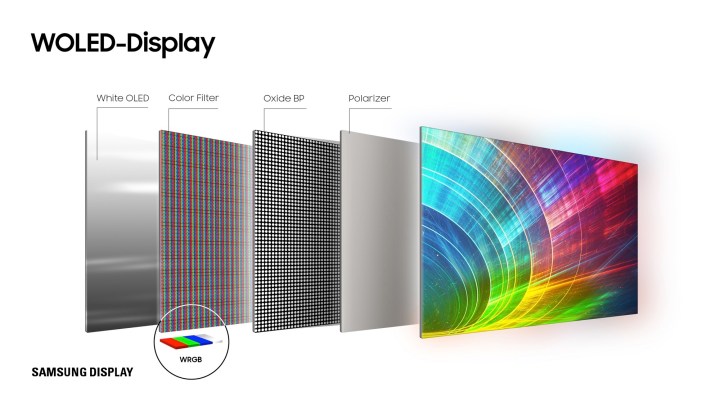
LG’s technique for regaining some of the brightness lost to the color filter involves the use of a white subpixel that bypasses the color filter.
When you’re watching standard dynamic range (SDR) content, the use of that white subpixel is moderate. OLED TVs can easily get bright enough to meet the full specification for SDR without relying heavily on the brightness of the white subpixel.
“Displays of all types that use this architecture are able to achieve color accuracy at relatively lower luminance,” said Jeff Yurek, director of marketing and investor relations at Nanosys, a company that develops quantum dot technology. But HDR material is a bit trickier.
When viewing HDR content, the panels turbocharge these white subpixels to deliver HDR’s higher brightness. But there’s a limit to how hard you can drive those white subpixels. Push them too far and not only do you reduce the panel’s life, but that extra brightness can also wash out the color of the other subpixels, something that is especially noticeable when displaying small features like text, which can often look less crisp.
Back to blue
To deal with the technical hurdles of OLED brightness, QD-OLED TVs take a page out of QLED TV’s handbook. Using the same principle that lets a QLED TV turn a blue backlight into a pure white light using red and green quantum dots, a QD-OLED panel uses just blue OLED material as the basis of each pixel.
That blue OLED pixel is then divided into three subpixels: A blue subpixel, which is the original blue OLED material, left unchanged; a red subpixel that layers red-tuned quantum dots over blue OLED; and a green subpixel that layers green-tuned quantum dots over blue OLED.
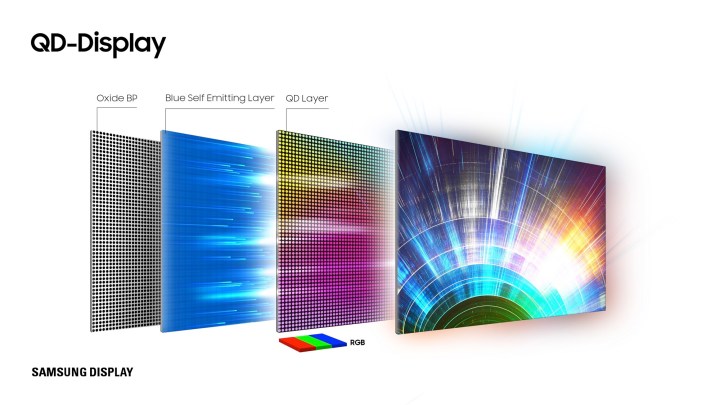
Since quantum dots are so energy-efficient, virtually no brightness is lost in those two color transformations. The result is a true RGB OLED display without the cost and complexity of a discrete RGB OLED starting point, the brightness tax of a color filter, or the need for a color-sapping white subpixel.
“What is so exciting about QD-OLED displays,” Yurek said, “is that they do not require a white subpixel to reach peak luminance. QD-OLED will be able to express the full color volume from near black all the way up to full-peak luminance without compromise.”
Starting small
If there’s one drawback to QD-OLED in its current state of development, it’s that it doesn’t come in a wide variety of screen sizes. As of December 2022, the biggest QD-OLED TV you can buy is a 65-inch 4K TV. There are no 8K QD-OLED TVs (yet).
That will change as more people buy the first-generation products and work on the manufacturing side continues to improve, but for now, QLED and OLED have a major advantage in terms of size and resolution: both now exist in screen sizes of up to 98 inches, in up to 8K resolution.
QD-OLED: more affordable?
It may take several years, but it’s possible that QD-OLED TVs will end up costing less than OLED TVs to make. Getting rid of the color filter is a great way to reduce materials and manufacturing complexity, which should mean a smaller outlay of cash.
And since QD-OLED will theoretically be brighter than OLED without the use of more electricity, it might be possible to create QD-OLEDs that have the same brightness as OLEDs while using less energy. Lower energy use brings down the cost of many of the components that have to be engineered to handle higher energy loads.
This all assumes that the investments needed to make QD-OLED manufacturing a reality will be paid off quickly, but that’s far from certain at this point.
Having your (OLED) cake and eating it, too
Blue OLED material — the light source of QD-OLED displays — is a notoriously tricky substance to work with.
Much like other OLED materials, there’s a three-way trade-off between lifespan, brightness, and efficiency. Generally speaking, any time you prioritize one of these attributes, the other two suffer. Drive an OLED pixel hard enough to produce the brightness you want and you not only diminish its life expectancy but also its efficiency.
But QD-OLED displays may prove to be the exception to this rule. By using three layers of blue OLED material per pixel, each layer can share the brightness burden.
“The amount of power needed from the blue OLED pixel in the QD-OLED to produce a given amount of front-of-screen brightness will be less,” said Jason Hartlove, CEO and president of Nanosys.
Who makes QD-OLED TVs?
- 1.
Samsung’s QD-OLED TV. - 2.
Sony’s QD-OLED A95K.
At the moment, Samsung Display — a division within Samsung that develops display technologies but doesn’t sell final products like TVs or monitors — is the only company manufacturing QD-OLED panels. It sells these panels to companies like Sony, Dell’s Alienware division, and Samsung Electronics (the Samsung division that makes and sells TVs). We expect other companies will join the ranks of Samsung Display’s QD-OLED customers now that the first highly positive reviews are in.
We’re confident that there will eventually be many companies selling QD-OLED TVs, but for now, it looks like Sony and Samsung are alone in this new field.
When will QD-OLED TVs be available to buy?
You can buy QD-OLED TVs right now, from Samsung and Sony, but you may not realize it because of the way each company names its products.
Sony’s QD-OLED is called the Sony Bravia XR A95K 4K HDR OLED TV — no mention of “QD” or quantum dots. Samsung, bizarrely, does the same thing with its QD-OLED TV, known as the Samsung OLED 4K Smart TV S95B.
Each model currently comes in both 55- and 65-inch screen sizes.
How much do they cost?
Samsung’s QD-OLED TVs cost considerably less than Sony’s, though as Senior Editor, Caleb Denison, points out, most people wouldn’t be able to appreciate the subtle improvements that Sony offers. This makes Sony’s price premium difficult to rationalize.
The Samsung OLED 4K Smart TV S95B starts at $2,100 for the 55-inch model, while the 65-inch version costs $2,800. However, we’ve seen discounts of up to $800 on these prices in 2022, so there are definitely deals to be had.
For its part, Sony sells the 55-inch Bravia XR A95K 4K HDR OLED TV for $2,800 and the 65-inch for $3,500. Not only are these regular prices much higher than Samsung’s, but the discounts we’ve seen are also less exciting — only about $200.
Is QD-OLED the last word in TV technology?
Nope!
Nothing halts the progress of technology, and the companies that manufacture quantum dots have their sights set firmly on the eventual domination of the TV landscape.
QDEL sounds like the holy grail of TV tech, doesn’t it?
Remember when we said that quantum dots use light energy at almost 100% efficiency to produce their own light? Well, it turns out that quantum dots aren’t picky about their diet. They can also be energized using electricity for what’s known as quantum dot electroluminescence, or QDEL. In our opinion, it’s QDEL panels that should be referred to as “QD Displays,” not QD-OLED panels, but this isn’t the first time the industry has chosen a confusing tech name, and it certainly won’t be the last.
Eventually, this means we’ll be able to ditch OLED and LED light sources and create ridiculously thin, flexible, colorful, bright, and energy-efficient displays that never diminish in brightness or color accuracy over time.
QDEL sounds like the holy grail of TV tech, doesn’t it? But we’re not quite there yet. At the moment, blue quantum dots possess the necessary attributes to act as electroluminescent subpixels; however, red and green quantum dots still need work.
Samsung currently makes a 110-inch, 4K microLED TV, but it doesn’t sell the product directly to buyers or through retail stores like Best Buy. Instead, you have to contact a Samsung-licensed AV installer. And if you have to ask how much it costs, well … you know how that one goes.
Still, just like QD-OLED, OLED, and plasma, it’s expected that microLED will soon become more affordable, more adaptable, and available in sizes that the average buyer might want. Keep your eyes peeled and focused on all the news coming out of CES 2023 for a peek at what’s to come.
Editors’ Recommendations
Fans of TV gear love to debate the merits of flat-panel technologies. In the past, this meant comparing Quantum Dot LED (or QLED TV as it’s most commonly known) and Organic LED, otherwise known as OLED TV. But 2022 was the year a new display technology called Quantum Dot OLED or QD-OLED, made its official debut, and it has already started to reshape the TV landscape thanks to new models from Sony and Samsung, and computer monitors from Dell’s Alienware brand.
But what exactly is QD-OLED, how is it different from both QLED and OLED, and why do experts think it represents the best picture quality you can get? Let’s take a deep dive into the details of QD-OLED and find out.
What is QD-OLED?
Simply put, QD-OLED is a hybrid display technology that takes the already very impressive qualities of OLED TV and improves its brightness and color through the use of quantum dots.
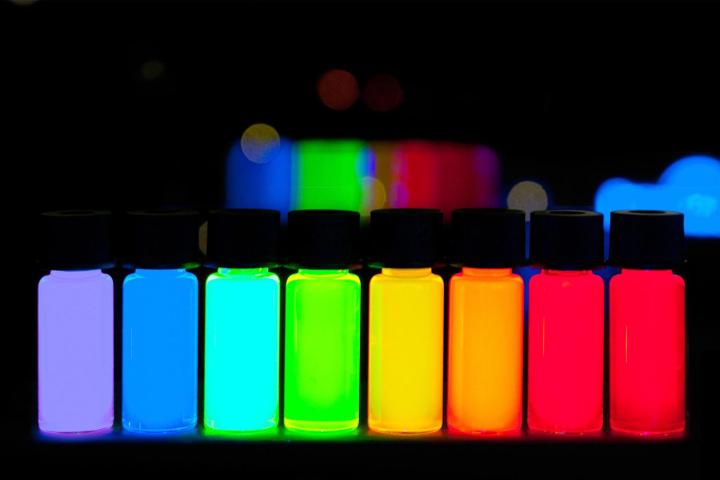
The result is a TV that exhibits the stunning levels of contrast and perfect blacks of OLED while delivering brightness levels that exceed anything we’ve seen from OLED so far.
This “best of both worlds,” benefit was largely theoretical until we got a chance to see it for ourselves at CES 2022. Those impressions survived even once we brought the first two QD-OLED TVs in for testing. First with the Sony A95K, and then again with the Samsung S95B. Both TVs earned a rare 10/10 rating from our reviewer.
Picture improvements aside, it’s also possible that over time, QD-OLED TVs may prove less expensive to buy than similarly sized OLED TVs. We’ll discuss this in more detail later. Since QD-OLED TVs are essentially an evolution of OLED, it’s expected that some of the clever things we’ve seen LG do with its OLED panels, like transparent displays and rollable displays, will soon be possible with QD-OLED, too.
How does QD-OLED work?
To understand the inner workings of QD-OLED, we need to quickly explain the differences between QLED and OLED.
QLED TV

QLED TV uses four main elements to produce its pictures: An LED backlight, a layer of quantum dots, an LCD matrix, and a color filter.
The LED backlight produces all of the brightness you see — and modern LED backlights can produce a lot of brightness, far more than OLED light sources. But achieving that brightness while maintaining a full-spectrum white, is difficult.
The solution: Start with a really bright blue LED light source, then use red and green quantum dots to balance the blue into a full spectrum of white. Because quantum dots can be tuned to emit specific colors and, amazingly, can do this at a nearly 100% efficiency level, QLED TVs get a much-needed improvement to their color accuracy without sacrificing any brightness or needing to use more energy.
From there, the purified white light passes through the LCD matrix (which is responsible for the images you see, and how bright or dark areas of the screen are) and, finally, through the color filter, which converts the white light into the right amounts of red, green, and blue so that we see true color images.

It’s a good system that produces bright and very colorful images. It’s also quite affordable to produce because, except for the quantum dots, all of the components have been around for decades, and are now “cheap” to make.
But it has drawbacks, too. No matter how hard the LCD matrix tries, it can’t block 100% of the light from coming through in dark scenes, so you never get that perfect, inky black that you see on an OLED TV. The LCD matrix also creates problems for off-angle viewing because it tends to “tunnel” light straight outward from the screen.
QLED also has to use more energy to create the brightness you see because the combination of the LCD matrix and the color filter diminishes the light the LED backlight generates. This makes QLED TVs less energy efficient than OLED TVs.
Finally, and this may only matter to decor-oriented TV buyers, all of those elements add up to a thicker overall TV panel.
OLED TV
OLED TV uses an OLED light source and a color filter to produce its image.
That sounds remarkably simple compared to QLED TV, and it is. Thanks to the emissive nature of the basic element of OLED TV — the OLED pixel — this one ingredient can take care of brightness and image creation, essentially fulfilling the roles of both the LED backlight and the LCD matrix in QLED TV.
Without an LCD matrix, viewing angles with OLED TV are as near-perfect as we’ve ever seen. You can sit wherever you like and still see the same levels of brightness, contrast, and color.
And as we’ve already hinted at, because OLED pixels can be shut off completely when an image calls for perfect blackness, that’s exactly what you get: No light being emitted at all.
But OLED TV isn’t perfect either. You can only derive so much brightness from an OLED pixel. It’s excellent in low-light conditions, but it simply can’t compete with QLED’s dedicated LED backlight in brighter environments. If you’ve ever looked at a QLED and OLED TV side by side in a brightly lit Costco warehouse and found the QLED TV more appealing, it’s probably due to its superior brightness.

OLED TV brightness is lower than QLED for two main reasons. First, and most importantly, each OLED pixel creates its own light. But the more power you drive through an OLED pixel, the more you shorten its lifespan. So OLED TVs could probably get brighter than they do today, but few buyers would be OK with a TV that only lasted half as long. The LEDs used in a QLED TV’s backlight are far less susceptible to this kind of aging and can continue to produce lots of light for a long time.
Second, no matter how much light an OLED pixel can create, some of that light will be absorbed by the color filter.
OLED panels are also susceptible to something known as burn-in. If you display the same kind of content on an OLED TV for tons of consecutive hours — say a lower info banner on a news channel, or a control panel in a video game — it can cause those pixels to age at a faster rate than the pixels that are constantly displaying different images.
The residual “shadow” of that static content is called burn-in, and once it happens, it’s usually permanent.
Finally, because the large-format OLED panel market is effectively a monopoly, with just one company — LG Display — manufacturing and selling them to companies like LG, Sony, Philips, and Vizio, it will remain more expensive than QLED for some time to come.
QD-OLED: Busting the brightness barrier
So the question that faces the TV world is, how can you hold on to all of OLED’s many benefits and improve on its weaknesses?
The solution is QD-OLED, also referred to by some companies as “QD Display.”
Quantum Dot OLED significantly increases the overall brightness of OLED — and even improves its already superb color — by optimizing how much light a single OLED pixel can emit and eliminating the color filter.
Here’s how it works.
Why start with white?
At the moment, OLED TVs create their light and color starting point with white light. They do this by combining blue and yellow OLED material to create a blend that comes very close to pure white. Why do this instead of using red, green, and blue OLED material? The answer has to do with the complexities of manufacturing OLED panels at the 50-inch to 88-inch sizes of today’s TVs while keeping costs as low as possible.
To give you a sense of just how expensive a true RGB OLED panel is, Sony makes a 4K, 55-inch monitor for the broadcast and film industries that uses this technology. It costs nearly $28,000.
But when you start with white light, you need a way to separate the individual red, green, and blue portions of the spectrum. A color filter does this admirably, but color filters, as we mentioned above, reduce brightness.

LG’s technique for regaining some of the brightness lost to the color filter involves the use of a white subpixel that bypasses the color filter.
When you’re watching standard dynamic range (SDR) content, the use of that white subpixel is moderate. OLED TVs can easily get bright enough to meet the full specification for SDR without relying heavily on the brightness of the white subpixel.
“Displays of all types that use this architecture are able to achieve color accuracy at relatively lower luminance,” said Jeff Yurek, director of marketing and investor relations at Nanosys, a company that develops quantum dot technology. But HDR material is a bit trickier.
When viewing HDR content, the panels turbocharge these white subpixels to deliver HDR’s higher brightness. But there’s a limit to how hard you can drive those white subpixels. Push them too far and not only do you reduce the panel’s life, but that extra brightness can also wash out the color of the other subpixels, something that is especially noticeable when displaying small features like text, which can often look less crisp.
Back to blue
To deal with the technical hurdles of OLED brightness, QD-OLED TVs take a page out of QLED TV’s handbook. Using the same principle that lets a QLED TV turn a blue backlight into a pure white light using red and green quantum dots, a QD-OLED panel uses just blue OLED material as the basis of each pixel.
That blue OLED pixel is then divided into three subpixels: A blue subpixel, which is the original blue OLED material, left unchanged; a red subpixel that layers red-tuned quantum dots over blue OLED; and a green subpixel that layers green-tuned quantum dots over blue OLED.

Since quantum dots are so energy-efficient, virtually no brightness is lost in those two color transformations. The result is a true RGB OLED display without the cost and complexity of a discrete RGB OLED starting point, the brightness tax of a color filter, or the need for a color-sapping white subpixel.
“What is so exciting about QD-OLED displays,” Yurek said, “is that they do not require a white subpixel to reach peak luminance. QD-OLED will be able to express the full color volume from near black all the way up to full-peak luminance without compromise.”
Starting small
If there’s one drawback to QD-OLED in its current state of development, it’s that it doesn’t come in a wide variety of screen sizes. As of December 2022, the biggest QD-OLED TV you can buy is a 65-inch 4K TV. There are no 8K QD-OLED TVs (yet).
That will change as more people buy the first-generation products and work on the manufacturing side continues to improve, but for now, QLED and OLED have a major advantage in terms of size and resolution: both now exist in screen sizes of up to 98 inches, in up to 8K resolution.
QD-OLED: more affordable?
It may take several years, but it’s possible that QD-OLED TVs will end up costing less than OLED TVs to make. Getting rid of the color filter is a great way to reduce materials and manufacturing complexity, which should mean a smaller outlay of cash.
And since QD-OLED will theoretically be brighter than OLED without the use of more electricity, it might be possible to create QD-OLEDs that have the same brightness as OLEDs while using less energy. Lower energy use brings down the cost of many of the components that have to be engineered to handle higher energy loads.
This all assumes that the investments needed to make QD-OLED manufacturing a reality will be paid off quickly, but that’s far from certain at this point.
Having your (OLED) cake and eating it, too
Blue OLED material — the light source of QD-OLED displays — is a notoriously tricky substance to work with.
Much like other OLED materials, there’s a three-way trade-off between lifespan, brightness, and efficiency. Generally speaking, any time you prioritize one of these attributes, the other two suffer. Drive an OLED pixel hard enough to produce the brightness you want and you not only diminish its life expectancy but also its efficiency.
But QD-OLED displays may prove to be the exception to this rule. By using three layers of blue OLED material per pixel, each layer can share the brightness burden.
“The amount of power needed from the blue OLED pixel in the QD-OLED to produce a given amount of front-of-screen brightness will be less,” said Jason Hartlove, CEO and president of Nanosys.
Who makes QD-OLED TVs?
- 1.
Samsung’s QD-OLED TV. - 2.
Sony’s QD-OLED A95K.
At the moment, Samsung Display — a division within Samsung that develops display technologies but doesn’t sell final products like TVs or monitors — is the only company manufacturing QD-OLED panels. It sells these panels to companies like Sony, Dell’s Alienware division, and Samsung Electronics (the Samsung division that makes and sells TVs). We expect other companies will join the ranks of Samsung Display’s QD-OLED customers now that the first highly positive reviews are in.
We’re confident that there will eventually be many companies selling QD-OLED TVs, but for now, it looks like Sony and Samsung are alone in this new field.
When will QD-OLED TVs be available to buy?
You can buy QD-OLED TVs right now, from Samsung and Sony, but you may not realize it because of the way each company names its products.
Sony’s QD-OLED is called the Sony Bravia XR A95K 4K HDR OLED TV — no mention of “QD” or quantum dots. Samsung, bizarrely, does the same thing with its QD-OLED TV, known as the Samsung OLED 4K Smart TV S95B.
Each model currently comes in both 55- and 65-inch screen sizes.
How much do they cost?
Samsung’s QD-OLED TVs cost considerably less than Sony’s, though as Senior Editor, Caleb Denison, points out, most people wouldn’t be able to appreciate the subtle improvements that Sony offers. This makes Sony’s price premium difficult to rationalize.
The Samsung OLED 4K Smart TV S95B starts at $2,100 for the 55-inch model, while the 65-inch version costs $2,800. However, we’ve seen discounts of up to $800 on these prices in 2022, so there are definitely deals to be had.
For its part, Sony sells the 55-inch Bravia XR A95K 4K HDR OLED TV for $2,800 and the 65-inch for $3,500. Not only are these regular prices much higher than Samsung’s, but the discounts we’ve seen are also less exciting — only about $200.
Is QD-OLED the last word in TV technology?
Nope!
Nothing halts the progress of technology, and the companies that manufacture quantum dots have their sights set firmly on the eventual domination of the TV landscape.
QDEL sounds like the holy grail of TV tech, doesn’t it?
Remember when we said that quantum dots use light energy at almost 100% efficiency to produce their own light? Well, it turns out that quantum dots aren’t picky about their diet. They can also be energized using electricity for what’s known as quantum dot electroluminescence, or QDEL. In our opinion, it’s QDEL panels that should be referred to as “QD Displays,” not QD-OLED panels, but this isn’t the first time the industry has chosen a confusing tech name, and it certainly won’t be the last.
Eventually, this means we’ll be able to ditch OLED and LED light sources and create ridiculously thin, flexible, colorful, bright, and energy-efficient displays that never diminish in brightness or color accuracy over time.
QDEL sounds like the holy grail of TV tech, doesn’t it? But we’re not quite there yet. At the moment, blue quantum dots possess the necessary attributes to act as electroluminescent subpixels; however, red and green quantum dots still need work.
Samsung currently makes a 110-inch, 4K microLED TV, but it doesn’t sell the product directly to buyers or through retail stores like Best Buy. Instead, you have to contact a Samsung-licensed AV installer. And if you have to ask how much it costs, well … you know how that one goes.
Still, just like QD-OLED, OLED, and plasma, it’s expected that microLED will soon become more affordable, more adaptable, and available in sizes that the average buyer might want. Keep your eyes peeled and focused on all the news coming out of CES 2023 for a peek at what’s to come.
Editors’ Recommendations


